9 basic types of wedding bouquets and their features

The wedding bouquet is the main floral decoration of the wedding day, which complements the bride's outfit and is combined with the general decor of the ceremony. There are many styles of flower arrangements, depending on the shape, the type of flower used, and the style of the ceremony. A classic medium-sized bouquet is suitable for a church wedding, while a larger, laid-back floral arrangement complements a garden ceremony. This quick guide will help brides choose their ideal one.
How to create a wedding bouquet
The creation of a bouquet begins with the choice of a flower or a shape for a composition. If the flower has already been chosen even without a color scheme, the appropriate shape of the bouquet is selected. Peonies and roses work well for round wedding arrangements; options with greenery look great in a cascading style. If the shape of the bouquet is initially selected, it is worth choosing the right flowers that will look good depending on the color, season, location of the celebration. Flowers for wedding bouquets are chosen depending on their appearance, seasonality, symbolic meaning. Roses, peonies, dahlias, ranunculus, sweet peas, hydrangeas, tulips, orchids and other plants can be found in flower catalog.
Popular forms of wedding bouquets
Bridal bouquets are available in various forms, the most popular of which are:
- Round - a voluminous flower ball that looks the same from all sides and is held with both hands. Round wedding bouquets are usually collected from flowers of the same type without adding greenery or a combination of flowers of the same color and texture. The stems are tied tightly together with a silk ribbon. The bouquet should be uniform and symmetrical. It is best to use bulbous flowers, including roses and anemones.Plain round bouquets in light colors are popular, but mixed multi-colored compositions that emphasize a unique style also look beautiful. Round bouquets are found at classical ceremonies and usually consist of roses, peonies, buttercups, gerberas, and arrangements of parrot tulips are possible.
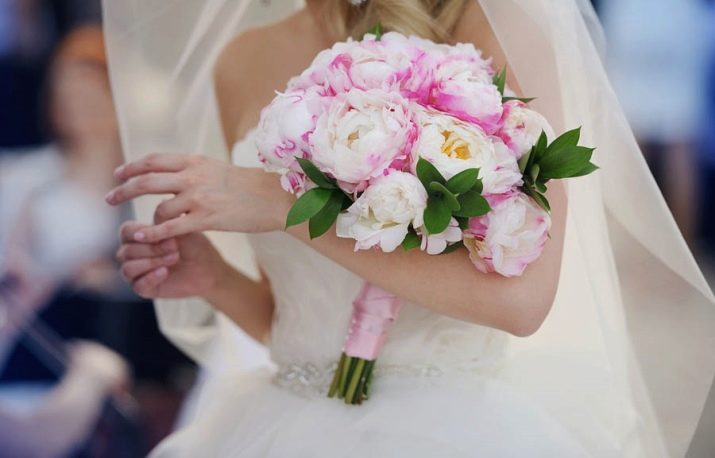
- Crescent - a bouquet that repeats the shape of a crescent in a horizontal view. The flowers are tightly folded in the center and taper down on both sides. Shrub roses, calla lilies, clematis, tulips, fritillaria, branches of greenery look most organically in a tilted crescent bouquet. A great option for a romantic boho-chic wedding, garden ceremony.
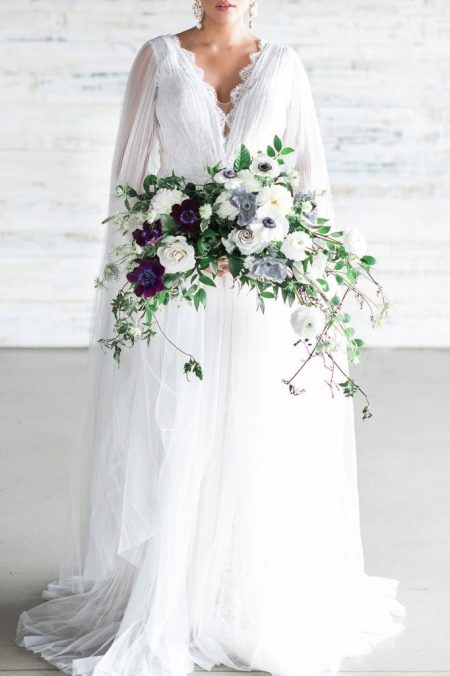
- Cascading - an elongated vertical bouquet, where flowers cascade down like a waterfall. Cascades come in different lengths and volumes, look harmoniously with fresh hanging greenery, like a grapevine. A long cascade accentuates the dress with a long train. Orchids are often added to the composition, as they grow in a natural cascade, calla lilies on long stems. There are many other flower options, for example, garden roses, peonies, holly, Japanese anemone, clematis, amaranth, eucalyptus, ivy, clematis, sandersonia, scabiosa, poppy, lupine, foxglove, fritillaria. Cascading compositions of vine branches, fresh foliage, intertwined with flowers to achieve a crescent shape are popular. This type of bridal bouquet is a colorful decoration in itself, so the bride's wedding dress and accessories should be pretty simple. A lush, voluminous cascading white bouquet of gardenias, freesias, stephanots, orchids, lilies of the valley, roses, lilies, jasmine, Mountbatten roses, ivy, myrtle adorned Princess Diana's outfit at her wedding with Prince Charles.

- Drop-shaped - a classic drop-shaped bouquet, the forerunner of the cascading composition. Much smaller than a cascade. The flowers are more densely folded. Kate Middleton chose a white teardrop-shaped bouquet of hyacinths, lilies, ivy, myrtle for her wedding with Prince William.
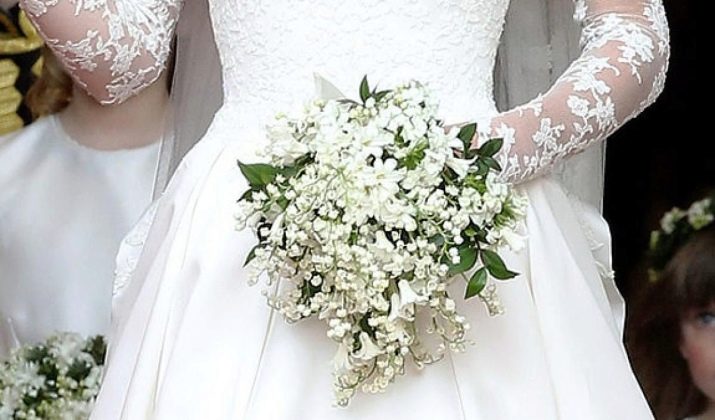
- Posy is a minimalistic round bouquet held in one hand. This is a smaller version of the classic round version. Flowers are collected in a round dome. Stems are cut to equal length and tied tightly. The bouquet can be complemented with a small amount of greenery. This type of composition was chosen by Meghan Markle for her wedding with Prince Harry, who carried to the altar a small symbolic white bouquet with greenery, consisting of astilbe, astrantia, lily of the valley, forget-me-nots, sweet pea myrtle.
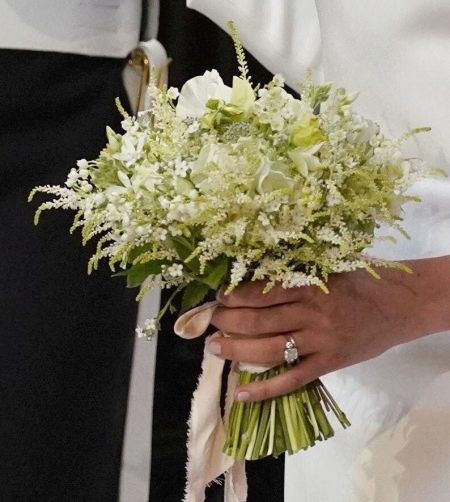
- Hand-knitted - a bouquet of a natural, relaxed shape, manually tied with a simple ribbon, cloth or twine. Often contains three or four identical long-stemmed flowers such as delphinium, calla lilies or peonies, and several types of greenery. Hand-knitted bouquets create the feeling of a freshly cut flower and are perfect for garden, country ceremony, boho chic events.

- Asymmetrical - a horizontal arrangement of flowers and greenery with an asymmetric shape. Usually, one side of the bouquet is noticeably higher than the other, which looks original and natural. The asymmetrical bouquet is tied with a ribbon, often includes greenery, a wide variety of flowers with different stem lengths.

- Nosegay is an elegant miniature round bouquet that dates back to the Victorian era. The Nosegay bouquet, like Posy, is small and tightly knitted by hand. This is a bunch of flowers of one predominant species. The stems are cut to the same length and wrapped with silk ribbon or lace, which adds sophistication and elegance. Its compact size makes it easy to hold in one hand. A greater emphasis in the composition is placed on greenery, and not on flowers, although roses, calla lilies, orchids are often popular. Neat, small wedding compositions are often collected from ranunculus, sweet peas, hyacinths, and peonies.This type of arrangement goes well with a bouquet of bridesmaids, flower girls or mother of the bride due to its small compact size.
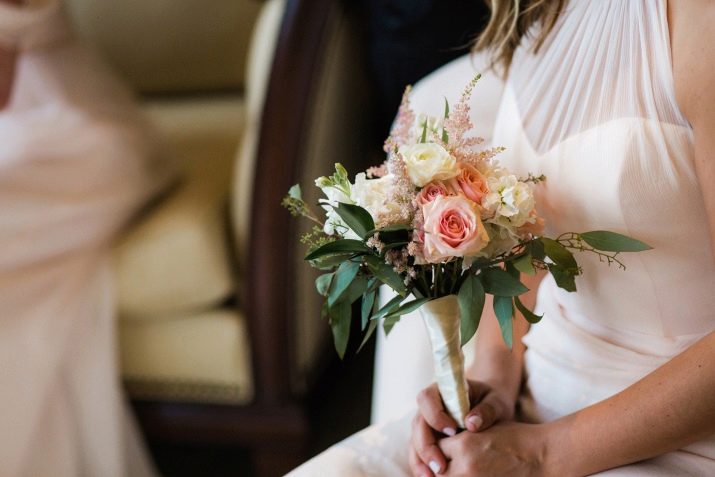
- Pomander, also known as a kissing ball, is a round ball of tightly folded flowers in a vintage style. It has a decorative ribbon loop that is worn around the wrist. The composition is usually assembled by florists, as creating a flower coverage 360º compared to the standard 180º is a laborious process. Pomander is usually collected from one or a combination of different types of flowers without foliage - garden roses, buttercups, tulips, peonies, carnations, gerberas. The stems are hidden inside the ball. Pomander is adorned with precious stones. Due to the possibility of hanging, it is used as a decoration. The smaller version is suitable for flower girls as it is easy to hold.
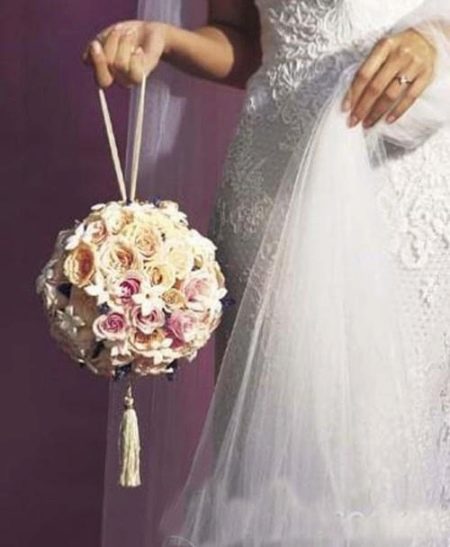
There is no single rule for choosing a wedding bouquet. The decision is entirely up to you.
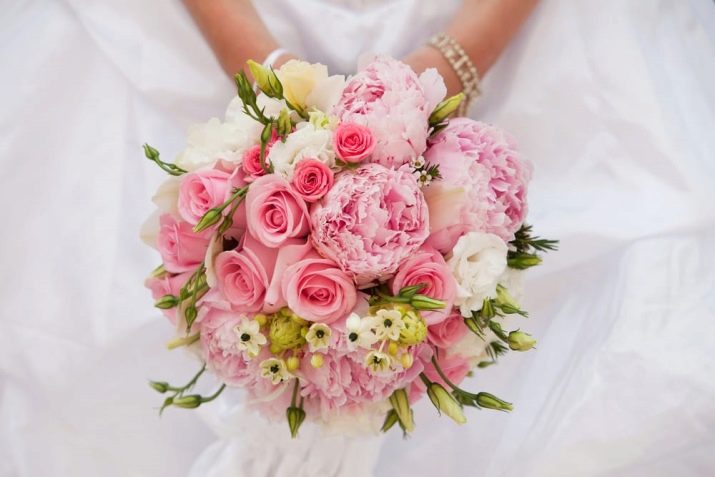
Conclusion
In floristic companies you can order flower delivery and making an individual composition. Unique wedding bouquets, collected taking into account the type of flower, color scheme, size, shape of the composition, season, location and style of the celebration, look special. A correctly selected bouquet from all possible options - from classic round domes to original cascading compositions - complements the bride's outfit and the general decor of the celebration, enlivening the whole ensemble and setting the mood of the holiday.








